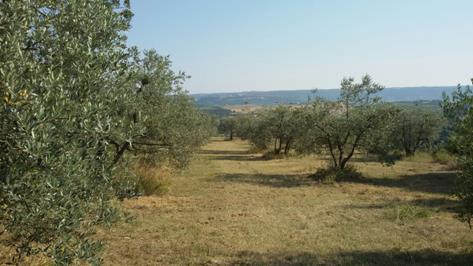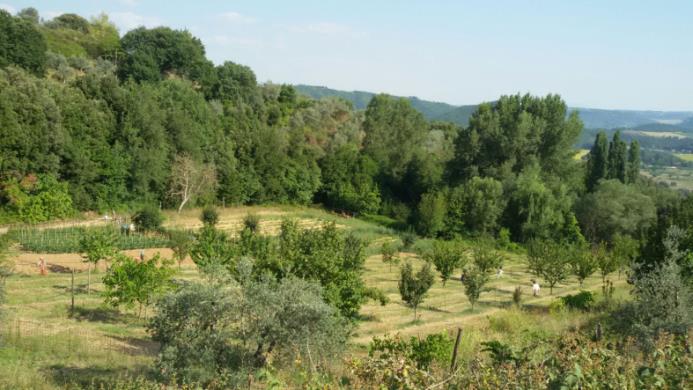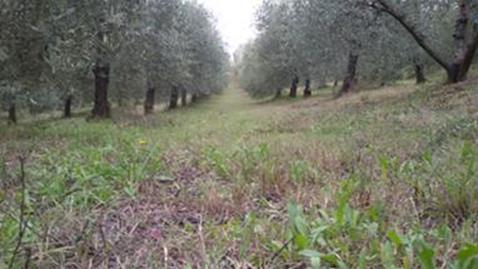by Andrea Pisanelli, Italy
“Darliner” is a small-scale farm constituted in 2010 by Veronica and Stefano, with their 3 young sons (Giorgio, Flavio and Emiliano). The farm is located in the southern-west part of Umbria Region, Central Italy. Around the farm, a mosaic of agroforestry systems, at different level of complexity, characterizes the rural landscape. Olive groves, often managed in combination with pasture or intercropped with cereals, and vineyards are the most common agricultural crops on hilly lands. Other crops, such as sunflower and tobacco are cultivated in small portion of plain lands. Agricultural fields are usually alternated with wooded lands with oaks, ash, maple, etc. managed as coppice to produce fuelwood destined to local energy market.
Veronica and Stefano are 40 years old and were born in Rome. They moved to Umbria Region about 10 years ago, wishing to find a better quality of live in a rural area in comparison to the big city, in particular for their children. The overall objective of the farmers is to produce enough food and energy to self-sustain the family in an environmental friendly way. Since Veronica and Stefano started agricultural activity without any specific background and experience, they began to get basic technical skills and knowledge by consulting their neighbour farmers.

The farm size is about 7 ha, including the house where the family lives. About 0.7 ha are managed as fruit orchards (Figure 2) in which several traditional varieties of fruit species, such as mulberry, apricot, apple, almond, quince tree, etc., are currently cultivated intercropped with aspagarus and artichokes.
Fruits are usually processed to produce delicious homemade jams. Farm includes also 0.2 ha of arable field where cereals are produced mainly to feed poultry, and legumes are grown for home consumption. In addition, in a small portion of the farm land, the feasibility of producing new products such as raspberries and other secondary products is being tested and experimented with the aim to integrate farm income.

About 4 ha of the farm land are managed with olive orchards. Olive trees comprise local and traditional varieties and are managed according to two planting schemes: in the first one about 600 trees (approximately 40 years old) are planted at a spacing of 6x6 m (Figure 3); in the second about 300 older olive trees are planted at wider distance (about 12x12 m) allowing the intercropping with arable crops (Figure 1).
Farm comprises also small wooded areas managed to collect wood that is used to satisfy the energy need of the farm. In addition, awater source and a small artificial water basin are included in the farm. The water is used to irrigate the homegarden where various seasonal vegetables are cultivated in rotation, allowing the production of different vegetables during the whole year.

In terms of economic revenue, the extra-virgin olive oil is the most important product of the farm. Olive orchards usually produce about 9 tons of olives per year. Olives are usually collected at the beginning of November and processed in a local olive mill. The annual extra-virgin olive oil production is about 1,200 litres. The olive oil is mainly destined to domestic market; a limited percentage is sold abroad. Pruning olive trees and harvesting olives are the most costly management practices, in terms of labour. Soil fertility is integrated using only manure, without any chemical fertilizers or treatments, and all the farm products are really organic. Moreover, phytosanitary control of pathogens, in particular olive fly, is carried out adoption biological methods. Olive orchards are kept with natural grass between the tree rows and weed is periodically mown. In terms of expenses, the olive process at the oil mill accounts about 43% of the total cost. In addition, about 26% of the expenses are related to the administrative management costs. Since they are a young family with 3 children, Veronica and Stefano claim the lack of appropriate economic support (i.e. subsides) from the public institutions to their farm. The Single Farmer Payment, within the current CAP, is limited and it allows to cover just taxes and farmer association costs.
Veronica and Stefano attempt to get new ideas and to improve their skills by means of technical journals and through the exchange of knowledge with other farmers living around. Currently, they are starting to breed poultry free-range grazing, with the main aim to increase the household income respecting the animal welfare.











